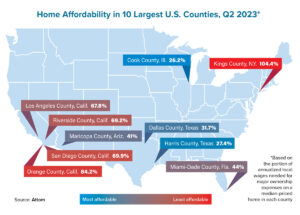The United States mortgage market plays a unique role in the country’s real estate financial environment. It allows individuals, businesses and investors to secure needed funds from financial institutions, such as banks, credit unions and mortgage bankers to purchase commercial real estate. These transactions, commonly referred to as “mortgages,” are secured by the real estate being acquired.
It is important for commercial brokers to have a strong understanding of the real estate mortgage market in general and the commercial market in particular. Knowing these markets is fundamental to a broker’s success in the industry.
Expansive market
One of the largest asset classes in the world, the U.S. real estate mortgage market has approximately $12 trillion in outstanding mortgage debt. It is larger than the gross domestic product of all but two countries in the world, China and the United States.
Commercial real estate refers to properties used for business or income-generating purposes. According to the Mortgage Bankers Association (MBA), the total commercial and multifamily outstanding debt reached $4.6 trillion at the end of the second quarter of 2023, with multifamily properties accounting for just over $2 trillion. Banks and savings and loan institutions hold about $2.9 trillion in commercial mortgages. The rest is divided among various sectors, including U.S. mortgage-finance agencies and life insurance companies.
“The real estate mortgage industry has created new procedures, policies and creative financial concepts to provide solutions to liquidity and other problems that have plagued the industry for a long time.”
Typically, commercial properties are leased. Some businesses own buildings or properties that they occupy, however. When buying a property, the U.S. government plays a significant role in today’s mortgage market, primarily through direct subsidies, such as rent support for low-income renters, or indirect subsidies, such as tax breaks for developers who construct affordable housing.
In addition, funding support is provided by two major buyers that dominate the market, the Federal National Mortgage Association, commonly known as Fannie Mae, and the Federal Home Loan Mortgage Corporation, commonly known as Freddie Mac. Together these two government-sponsored enterprises (GSEs) hold approximately 66% of all outstanding mortgages, providing stability and liquidity to the market by purchasing commercial mortgage loans from lenders.
An ongoing financial dilemma faced by almost all financial institutions, especially mortgage lenders, is the challenge of maintaining an acceptable level of liquidity. This is a concept known in the banking industry as asset and liability management, which means matching assets to liabilities, thus allowing the financial institution to pay its debts (return of depositor’s funds) when requested by the customer.
Liquidity solutions
The real estate mortgage industry has created new procedures, policies and creative financial concepts to provide solutions to liquidity and other problems that have plagued the industry for a long time. Currently, the mortgage market is divided into three main components: primary, secondary, and capital markets.
The primary mortgage market plays a pivotal role in the commercial industry, providing a consistent flow of funds from lenders to borrowers. It is the initial marketplace where borrowers secure real estate financing, dealing directly with mortgage lenders to obtain funding.
This market encompasses various key players that actively participate in the mortgage-lending process. The players include commercial banks, credit unions, mortgage bankers and other financial institutions. The entities act as intermediaries between borrowers and the secondary market.
The primary market encourages commercial property investment and helps drive the real estate industry forward. By providing access to funds, it enables individuals, businesses and investors to purchase homes and invest in commercial real estate properties. Without the primary mortgage market, many potential buyers would face significant challenges in acquiring the necessary financing to accomplish their objective of investing in commercial real estate.
Additionally, the primary mortgage market directly impacts interest rates and mortgage terms, influencing borrowing costs for buyers. Lenders actively compete for borrowers, continually evaluating the interest rates they offer to remain competitive and relevant in the market. Changes in interest rates in the primary mortgage market ripple through the economy, impacting consumer spending, the real estate market and overall economic stability.
Once lenders originate mortgages, they often sell them to investors, in turn enabling them to restock their capital and continue to lend to new investors. This practice promotes liquidity in the primary market and expands the availability of mortgage financing.
Secondary markets
The secondary mortgage market provides numerous necessary functions that are critical for the operation of the overall mortgage industry. It offers liquidity to primary mortgage lenders by purchasing the new mortgages recently funded. This allows lenders to replace their capital and generate new loan transactions, which encourages additional lending to potential new homeowners and investors.
A simple definition of the secondary market is that it refers to what happens after the loan is originated. The secondary market comes into play when investors buy out existing investors in an active project, according to Secondre.com, a broker-dealer registered with the SEC that operates an Alternative Trading System (ATS).
There are hundreds, perhaps thousands of secondary mortgage buyers, including many lenders in the primary market, such as commercial banks, credit unions, insurance companies, mortgage companies and many more. As mentioned earlier, Fannie Mae and Freddie Mac are the dominant players in this sector, holding about two-thirds of all outstanding mortgages, including commercial mortgage loans from lenders. The two GSEs also purchase and insure multifamily mortgages. The 2024 volume caps for multifamily loan purchases of Fannie Mae and Freddie Mac will total $140 billion, according to MBA.
In addition, the secondary market enables mortgage loans to be pooled together and packaged into mortgage-backed securities (MBS). These loan pools are then converted into securities and sold to investors, who receive continuous payments from the cash flow generated by the principal and interest payments on the core mortgage loans. This process, known as securitization, permits the lenders to offload the risk associated with the transaction to investors, while at the same time offering investors an opportunity to expand their respective portfolios.
Capital markets
The capital mortgage market refers to a network of financial institutions and investors that are involved in the lending and borrowing of funds for real estate transactions. It encompasses both residential and commercial mortgages, serving as a vital source of capital for the sale and purchase of real estate. Capital markets support the liquidity of the mortgage markets and make funding more available by purchasing mortgage-related securities that are backed by Freddie Mac and other institutions.
Several factors influence the capital mortgage market. These include economic indicators such as the gross domestic product, inflation rate and employment level. Additionally, government fiscal policies, monetary policies and market outlook also play a significant role in shaping the market’s behavior.
Given the inherent risk in mortgage lending, the process of risk assessment is an important aspect of complex capital markets. Another aspect of the mortgage industry is the continuing changes brought by new technology, which is revolutionizing many aspects of capital markets, streamlining processes and enhancing overall productivity. Online platforms and other artificial intelligence tools have made it easier for borrowers to access mortgage products and compare rates. Moreover, innovations like blockchain technology and big data hold the potential to improve transparency and security throughout the market.
● ● ●
Understanding the strong forces in the capital mortgage market is crucial for brokers and investors seeking to function in the difficult world of commercial real estate financing. By studying the key market mechanisms and developments, borrowers and lenders can make informed decisions and adapt to the ever-shifting model. As technology continues to reshape the industry, it is crucial for brokers to stay current on emerging concepts and innovations that will further improve the accessibility and productivity of the capital mortgage market. ●
Author
-
Garry Barnes is managing director of PW Partners Consultancy, headquartered in Salt Lake City, and is a freelance writer. He is a former president and CEO of banks in Arizona, California and Utah. He has taught at the university level, and is a frequent writer and lecturer on banking, finance and real estate matters. Barnes has served on the U.S. Small Business Administration’s National Advisory Council and received the SBA Arizona Financial Services Advocate of the Year award.





